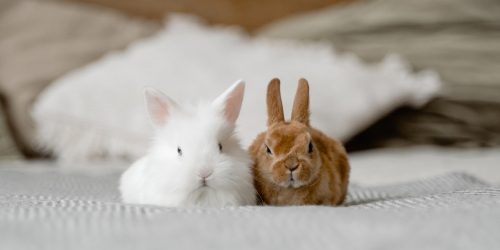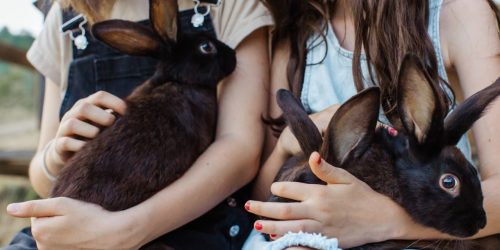Everything you need to know to adopt a rabbit
Extremely cute and sociable, rabbits, although traditionally linked to Easter and charm stories, have been increasingly adopted as pets. If you are looking for a different pet, then a rabbit can be an excellent suggestion – but before you take that step, find out everything you need to know to take a rabbit home.

WHY A RABBIT?
Aside from their naturally caring appearance, rabbits are intelligent, highly sociable animals and an excellent companion – everything you want in a pet, isn’t that right? Despite these benefits, you should also know that a rabbit is a pet that requires daily attention, both in terms of treatment and play, and can live for over 10 years.
SPACE & ACCOMMODATION
In terms of accommodation, a rabbit needs two things: a cage that is at least 4 times its size and an open-air space where it can be safely released. Rabbits tolerate cold temperatures well but they tolerate hot temperatures badly so their crate should be placed in a sheltered place, without draughts, without direct sunlight, and always properly packed with straw and wood shavings (a layer between 3 and 5 centimeters is recommended). If you put the cage inside, avoid also places with air currents, direct sun, heating, and air conditioning.
FOOD
The rabbit?s diet is mostly composed of specific rabbit food, straw, grass (as long as it does not contain pesticides), vegetables, fruit and water. Besides knowing which foods a rabbit can consume it is also important to know which foods are potentially dangerous for these pets. As a general rule the daily diet of an adult rabbit should be distributed as follows:
- A lot of straw and grass (about the size of the rabbit itself)
- 1 glass of green vegetables (at least 3 varieties) for every 2,300 kg of total rabbit weight
- ¼ feed cup for each 2,300-3,100 kg of total rabbit weight
- 1-2 tablespoons of fruit
- Besides this diet, a rabbit needs to drink plenty of water
HYGIENE
In general, rabbits are very neat pets, however, they can and should give you periodic baths with an appropriate shampoo. Rabbits with long hair need to be brushed and depending on the length of the hair some will have to be brushed daily. As with a dog or cat, one can also teach a rabbit to do its needs in an appropriate place.
As a general rule rabbits like to use the corners as toilets so put a litter suitable for rabbits in a corner where it is already usual to see the rabbit. During the first days, whenever the rabbit makes its needs outside of the designated place, take its little waste with a glove and put them in that litter. It may take some time but the rabbit will eventually learn that there is a place to do this and fulfill it. Curiously, the older the rabbits, the faster they learn.
CARE OF A RABBIT
- Remove any wet spots from your cage daily.
- Replace the straw/wood shavings at least every week.
- Clean the food and water containers every day.
- The food given to the rabbit which was not consumed within 24 hours should be removed.
- Release the rabbit from the cage every day, letting it run freely in an open but safe space.
- Avoid leaving the rabbit loose alone.
Physical contact is essential for the well-being of the rabbit and to strengthen the bond with its owners so pamper your rabbit every day!
After opening the cage door, let the rabbit come to you before you pick it up – do it with both hands, always supporting its hind legs.
Never hold the rabbit by the back of the neck or the ears.
When the time comes to put the rabbit back in the cage, try to persuade him in a gentle way to come back in using a command (which will always have to be the same) and avoiding running after him to catch him. In the early days however, or at least until he is trained, this will be inevitable.
Always wash your hands before and after picking up the rabbit.
HEALTH & WELL-BEING
It will be necessary to take the rabbit to the vet at least once a year: this check-up is essential to watch not only the general state of health but also the ears, the teeth, the length of the nails, and the existence of mites in the fur. However, if you notice any of the following signs, contact the veterinarian immediately:
- Apathy, inactivity
- Shortage of air
- Loss of consciousness
- Convulsions
- Opaque or cloudy eyes
- For the little bright, unhealthy
- Skin/fur injuries
- Lack of appetite, willingness to drink
- Extended diarrhea
- Very large/irregular teeth
GAMES & TOYS
Rabbits are more active in the early morning and late afternoon so these are the ideal moments to let your rabbit out of the cage and leave it free for a while. If you are going to release the rabbit outside, the area reserved for its play should be safe and free from any kind of predator; if you are going to release the rabbit inside, be careful not to leave electrical wires or other small objects which the rabbit can chew on.
Rabbits are animals that love to gnaw so they will have to acquire specific toys (preferably hard and resistant) so that the rabbit can gnaw at will and thus maintain its dental health.





